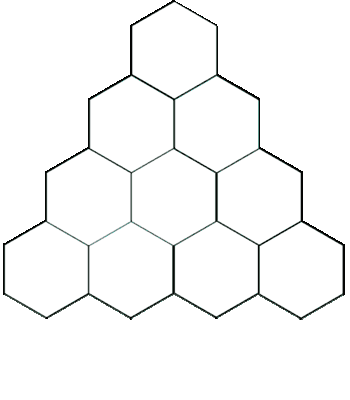| Unchanged: <h1>Pattern Exploration 3: Pascal's Triangle</h1> | Unchanged: <h1>Pattern Exploration 3: Pascal's Triangle</h1> |
| Unchanged: <a href="https://en.wikipedia.org/wiki/Blaise_Pascal">Blaise Pascal</a> was another famous mathematician who in 1653 published his work on a special triangle following a specific pattern. This became known as Pascal’s triangle, even though many other cultures have studied this pattern thousands of years before. The observations made from Pascal’s triangle has led to patterns related to probability and statistics, which we will explore later in the semester. | Unchanged: <a href="https://en.wikipedia.org/wiki/Blaise_Pascal">Blaise Pascal</a> was another famous mathematician who in 1653 published his work on a special triangle following a specific pattern. This became known as Pascal’s triangle, even though many other cultures have studied this pattern thousands of years before. The observations made from Pascal’s triangle has led to patterns related to probability and statistics, which we will explore later in the semester. |
| Unchanged: Take a look at Pascal’s triangle. The first number starts with a 1. Then continue to place the number 1 on the left and right edge of each number 1 from above. To obtain the missing number below, you add the two adjacent numbers above them. For example, you add the adjacent numbers 1 and 2 to obtain 3 below them. Fill in the rest of the triangle. | Unchanged: Take a look at Pascal’s triangle. The first number starts with a 1. Then continue to place the number 1 on the left and right edge of each number 1 from above. To obtain the missing number below, you add the two adjacent numbers above them. For example, you add the adjacent numbers 1 and 2 to obtain 3 below them. Fill in the rest of the triangle. |
Deleted: [caption id="" align="alignnone" width="350"]<img src="https://upload.wikimedia.org/wikipedia/commons/a/a4/PascalTriangleAnimated.gif" alt="Pascal's Triangle. Starts with 1 at the top. Second row 1 and 1. Third row 1, 2, 1. The two is obtained by adding the adjacent ones above." width="350" height="400" /> "Pascal Triangle Animated", Wikimedia Commons, is CC-BY-SA[/caption]
| Added: [caption id="" align="aligncenter" width="350"]<img src="https://upload.wikimedia.org/wikipedia/commons/a/a4/PascalTriangleAnimated.gif" alt="Pascal's Triangle. Starts with 1 at the top. Second row 1 and 1. Third row 1, 2, 1. The two is obtained by adding the adjacent ones above." width="350" height="400" /> "<a href="https://en.wikipedia.org/wiki/File:PascalTriangleAnimated.gif">Pascal Triangle Animated</a>", Wikimedia Commons, is <a href="https://creativecommons.org/licenses/by-sa/4.0/">CC-BY-SA 4.0</a>[/caption]
|
| Unchanged: Fill in the rest of the triangle up to 10 rows. | Unchanged: Fill in the rest of the triangle up to 10 rows. |
| Unchanged: <img src="http://pressbooks-dev.oer.hawaii.edu/kapccmath75x/wp-content/uploads/sites/70/2018/08/Pascal-Triangle.png" alt="Pascal's triangle with 13 rows. Fill out at least the first 10 rows." class="aligncenter wp-image-165 size-full" width="596" height="529" /> | Unchanged: <img src="http://pressbooks-dev.oer.hawaii.edu/kapccmath75x/wp-content/uploads/sites/70/2018/08/Pascal-Triangle.png" alt="Pascal's triangle with 13 rows. Fill out at least the first 10 rows." class="aligncenter wp-image-165 size-full" width="596" height="529" /> |
| Unchanged: | Unchanged: |
| Unchanged: <ol> | Unchanged: <ol> |
| Unchanged: <li style="font-weight: 400">Write down a few observations and patterns. Share your observations with your group. Try to get as many observations as you can.</li> | Unchanged: <li style="font-weight: 400">Write down a few observations and patterns. Share your observations with your group. Try to get as many observations as you can.</li> |
| Unchanged: <li style="font-weight: 400">What happens if you color in all the odd numbers and even numbers. What do you notice?</li> | Unchanged: <li style="font-weight: 400">What happens if you color in all the odd numbers and even numbers. What do you notice?</li> |
| Unchanged: <li style="font-weight: 400">Describe where you can find these sets of numbers found in Pascal’s triangle. Some are very easy to pick out, others may be identified by adding some of the cells together in a specific pattern. | Unchanged: <li style="font-weight: 400">Describe where you can find these sets of numbers found in Pascal’s triangle. Some are very easy to pick out, others may be identified by adding some of the cells together in a specific pattern. |
| Unchanged: <ol> | Unchanged: <ol> |
| Unchanged: <li style="font-weight: 400">Natural numbers</li> | Unchanged: <li style="font-weight: 400">Natural numbers</li> |
| Unchanged: <li style="font-weight: 400">Fibonacci numbers</li> | Unchanged: <li style="font-weight: 400">Fibonacci numbers</li> |
| Unchanged: <li style="font-weight: 400">Multiples of 2</li> | Unchanged: <li style="font-weight: 400">Multiples of 2</li> |
| Unchanged: <li style="font-weight: 400">Multiples of 3</li> | Unchanged: <li style="font-weight: 400">Multiples of 3</li> |
| Unchanged: <li style="font-weight: 400">Powers of 2: 2, 3, 8, 16</li> | Unchanged: <li style="font-weight: 400">Powers of 2: 2, 3, 8, 16</li> |
| Unchanged: <li style="font-weight: 400">Triangular numbers</li> | Unchanged: <li style="font-weight: 400">Triangular numbers</li> |
| Unchanged: <li style="font-weight: 400">Square numbers</li> | Unchanged: <li style="font-weight: 400">Square numbers</li> |
| Unchanged: <li style="font-weight: 400">Hexagonal numbers</li> | Unchanged: <li style="font-weight: 400">Hexagonal numbers</li> |
| Unchanged: <li style="font-weight: 400">Hockey stick pattern</li> | Unchanged: <li style="font-weight: 400">Hockey stick pattern</li> |
| Unchanged: <li style="font-weight: 400">Other patterns?</li> | Unchanged: <li style="font-weight: 400">Other patterns?</li> |
| Unchanged: </ol> | Unchanged: </ol> |
| Unchanged: </li> | Unchanged: </li> |
| Unchanged: </ol> | Unchanged: </ol> |



Feedback/Errata